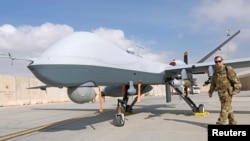The black-and-white aerial footage shows a line of purported Taliban insurgents slowly walking along a path in a lightly forested desert in Afghanistan's western Farah province. Suddenly, the screen flashes to white as the men disappear in a fireball — the result of a bomb dropped from a U.S. MQ-9 "Reaper" drone.
"Taliban fighters on the run following Afghan-led offensive in #Farah province, #Afghanistan. Video shows U.S. airpower (MQ-9s) in support," declared a short message accompanying the video, which was posted on the official account of the U.S. military in Afghanistan. Subsequent footage showed more Taliban scrambling, in an unsuccessful attempt to avoid the airstrikes.
The Pentagon footage was released Wednesday, as U.S., NATO and Afghan government forces were locked in a fierce battle with the Taliban for control of the capital of Farah, which borders Iran.
The tweet was unusually graphic. While the U.S. military often releases footage of buildings or vehicles being destroyed, it does not as frequently distribute videos that show individuals being bombed.
Less than 24 hours later, the U.S. Air Force posted its own Afghanistan-related tweet that raised eyebrows — this one referencing a viral audio clip that has sparked a lighthearted online debate among those who hear the word "Laurel" and others who hear "Yanny."
"The Taliban Forces in Farah city #Afghanistan would much rather have heard #Yanny or #Laurel than the deafening #BRRRT they got courtesy of our #A10," read the Air Force tweet.
The Air Force has since apologized and deleted the tweet, saying it was sent in "poor taste." The USFOR-A tweet remains.
In a statement to VOA, a Pentagon spokesperson said the tweets do not represent a new social media strategy.
"As with any other organization, the post was an attempt to bring awareness to a major/ongoing organizational activity by tying it to references or conversations already trending with their established audiences," said Lieutenant Colonel Kone Faulkner.
Some former U.S. military officials viewed the tweets as a departure from the more measured online messaging typical of the U.S. military.
"It isn't unusual for militaries around the world to speak publicly or show footage of their combat successes … but it's inappropriate to joke or be cute in tweets or other social media channels," said former Pentagon press secretary George Little.
It's unlikely that rank-and-file Taliban fighters would ever see the English-language tweets, or even be able to comprehend them. Afghanistan's literacy rate is only 31 percent, according to U.N. figures, and 70 percent of Afghans do not have access to reliable electricity.
"If someone thinks that members of the Taliban are going to understand the Laurel and Yanny reference, they're wrong, so jokes like this are often ineffective in addition to inappropriate," added Little, now a partner at the Brunswick Group.
"But it's probably just an airman who saw this and said, 'This is pretty cool, let's get it out there,' and the editing process failed," said David Des Roches, a retired Army colonel who teaches at the National Defense University.
Pentagon social media accounts have sometimes been used to send strong, although usually more subtle, messages to U.S. adversaries. For instance, U.S. Pacific Command has tweeted pictures of the nuclear-capable B-52 bomber when it takes part in joint military exercises with South Korea.
Following Trump’s lead?
U.S. President Donald Trump sometimes uses Twitter to send toughly worded messages or lob insults at his foreign counterparts, such as North Korean leader Kim Jong Un or Chinese President Xi Jinping.
Trump says his tough language and threats, along with expanded sanctions, helped persuade Pyongyang to participate in upcoming nuclear negotiations with the U.S.
The Afghanistan tweets, too, come as the U.S. tries to convince the Taliban to accept Afghan President Ashraf Ghani's offer of peace talks without preconditions.
On Thursday, the top U.S. commander in Afghanistan, General John Nicholson, released a Ramadan greeting in which he encouraged "all armed Taliban to accept [Ghani's offer] ... and join in peace talks, for a better future for their children and the noble people of this great nation."
The statement provided a stark contrast to the earlier tweets by USFOR-A and the U.S. Air Force. For some, the more conciliatory approach was preferable.
"At the end of the day, you're fighting insurgents, you're killing people who are relatives or friends of the people you're trying to convince to come over to your side," Des Roches said. "So you usually don't spike the ball in the end zone."










